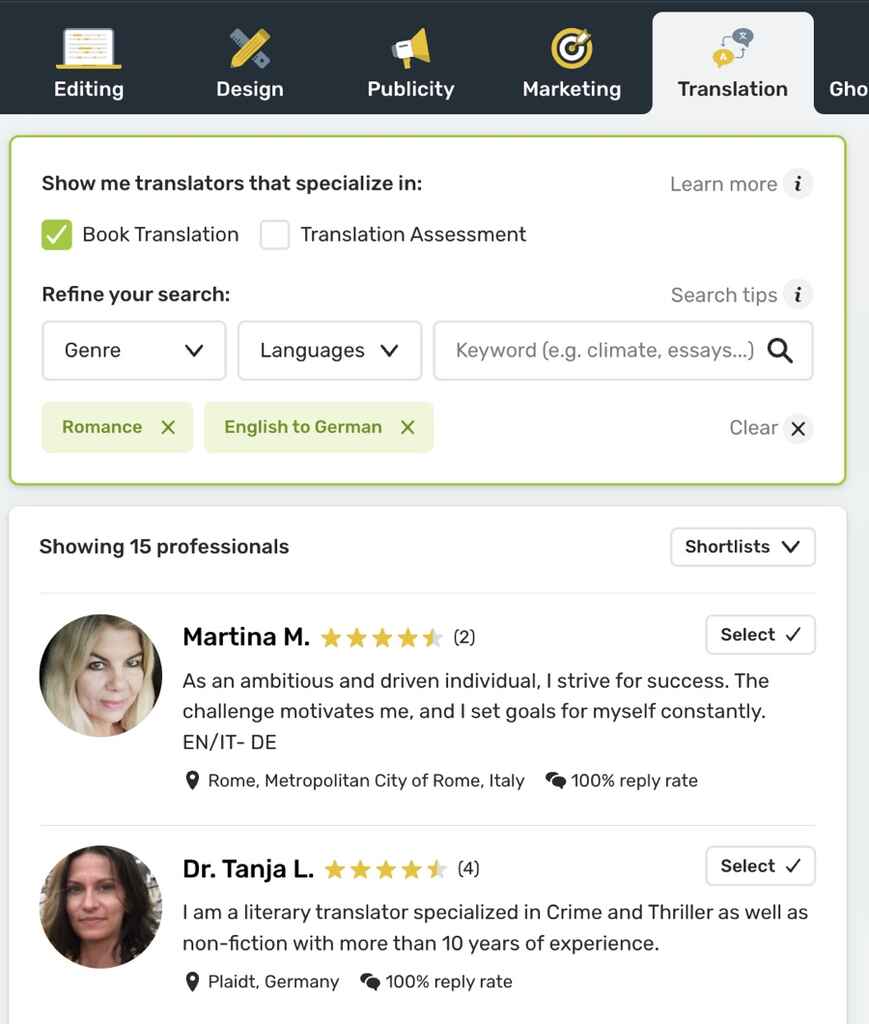Blog • Understanding Publishing
Last updated on Oct 15, 2025
How to Translate Your Book in 6 Simple Steps
Martin Cavannagh
Head of Content at Reedsy, Martin has spent over eight years helping writers turn their ambitions into reality. As a voice in the indie publishing space, he has written for a number of outlets and spoken at conferences, including the 2024 Writers Summit at the London Book Fair.
View profile →As of 2017, the US and UK made up just 34 percent of the global ebook market. This means that anyone who only self-published in English runs the risk of neglecting a whole 66 percent of the publishing pie. While not every author will necessarily benefit from translating their books into another language — those with a solid presence in their native language who are now looking to expand their reach may find it to be worth the extra effort.
If you’re ready to connect with new readers, sell more books, and develop your author brand and global footprint, then here are six steps to translate your book:
1. Find out where your strongest markets are
“Know your audience” is a maxim that you probably already recognize as an author. It’s important when you’re writing and selling a book in your own country, and doubly so when you’re selling a book abroad. Literary translators really don’t come cheap, as you’ll soon see: you should only get your book translated if you think you can recoup the cost in sales.
The key to coming out on the right side of this equation is understanding the global book market — and picking the ideal market to enter.
What are the most popular countries and languages for self-publishers?
Broadly speaking, the most popular foreign markets for independent authors are:
- Germany
- France
- Italy
- Spain
- India
- China
- Japan
The German market in particular is growing rapidly in terms of digital sales, so much so that Amazon decided to open up Amazon advertising to Germany before any other foreign market besides the UK. (We’ll discuss how to market your translated book more in a bit).
Lots of self-publishers also consider the proven Italian, French, and Spanish markets. And with their enormous reading populations and burgeoning book markets, the much more complex Chinese and Indian markets are nevertheless hard to overlook entirely.
Which foreign market should you enter?
Like any other big decision, you should choose your foreign market based on a ton of independent research. Keep in mind your personal position, and don’t make the mistake that a few unlucky protagonists in romcoms make: just because something is popular doesn’t necessarily mean that it’s a good or right fit for you and your book!
Here are a few things to do before deciding to swipe right on an international market:
- Study the general state of the foreign market. Besides making sure it’s viable for your book (the book market in India, for instance, is extremely fragmented with its 22 languages, including English), be sure to confirm its suitability for your specific genre. Fantasy might theoretically be a trendy genre in the Spanish market, but not so much in the Italian one.
- Check out the Amazon international marketplaces. If you’re interested in the German market, for example, check up on the books in your niche on Amazon.de. Same for the other foreign markets. This can help you gauge the popularity of your genre and your potential competition in that market.
- Review your existing international sales. Have you noticed that some of your English-language book sales are starting to come from, say, France? Great! You’ve got a running start. It might be a good idea now to follow the (proverbial) scent, and get your book translated first into French — especially since you’ve already got that built-in French fanbase, which will prove very useful when you’re marketing the French edition of your book.
Though it might be tempting to cast your net wide, a good rule of thumb is to target only one market at a time. Just like big companies that expand internationally step by step, this will give you the opportunity to systematically test your book on new audiences. Until you’ve got at least two to three books out, it’s hard to gain a foothold in any market.
2. Search for book translators with experience
Just in case it needs to be said: don’t translate your book yourself. Just don’t do it. Don’t even attempt it. Don’t go to Google Translate, plug your book into the text box, and think about publishing whatever it spits back out. Spoiler alert: your new readers will not be impressed, especially when Google translates “poultry for sale” into their language as “sell the chicken murder.”
This is because translating books into a whole new language is hard. You’re not just translating words: you’re translating ideas, and all of the subtle nuances that come package-and-parcel with English. Unless the target language is your mother tongue, we strongly recommend that you get a professional to do it for you. Here’s the good news: you can find professional literary translators right around the corner.
Translation companies vs. freelance literary translators
Sure, translation services are generally on standby to translate any kind of written work. But such services offer faceless translators who are generally not specialized in literary translation for books, which is an incredibly important skillset to find in a translator if you want to be totally confident about the finished product that’s going to be placed back in your hands.
If you’re serious about producing a quality translation of your book, there’s no real replacement for a professional literary translator. Their insight, years of training, and familiarity with the book industry situates them in a uniquely helpful position to work with self-publishers. Many independent authors also develop long-term partnerships with their book translators, which can prove incredibly fruitful for future projects.

The most straightforward way to find such a translator is to browse a trusted marketplace. You’ll find many professional literary translators here on Reedsy, for instance, who have worked for the biggest publishing companies in their respective countries, and often on bestselling titles. They know exactly how to produce a faithful translation that sells.
The industry's best translators are on Reedsy
Pamela M.
Available to hire
English to German translations for over 300 finished books, including Romance, Thriller, Horror Novels. Unusual topics are no issue at all.
Terry L.
Available to hire
I'm an experienced freelance literary translator who's translated 23 books in a variety of genres; some of my translations were bestsellers.
Sarah C.
Available to hire
I'm a bookworm and seasoned English/Spanish into French literary (and non-literary) translator with an MA in Literary Translation.
3. Have a discussion with your shortlist of translators
A collaboration with a book translator is a serious commitment — which is why you want to make absolutely sure that you’ve picked the translator who’s the best fit for you and your book.
What should you know before committing to a collaboration?
Out of all the publishing professionals out there who work with independent authors, the translator is probably most similar to the ghostwriter in terms of their skillset. You want a translator who can capture your voice, carry over your thoughts, and align your vision in an entirely new language. Even more than that, you want someone who gets your story.
So grab a shovel and be prepared to dig a bit deeper when it comes to each translator that you find. To match with a trusted professional who can carry out a translation that lives up to the original, be sure to know:
- How much input will you be able to give? Will you get to provide feedback?
- Will you get to retain full ownership over the translated work? Who will own the copyright to the translated edition of the work?
- What’s the translator’s track record? What titles have they translated recently?
- Which genre (or genres) does the translator primarily work in?
- Can the translator provide samples of past work?
- What’s the timescale? When can they reasonably finish the translation?
- What’s the literary translator’s fee?
Though rates will differ from professional to professional, you can generally expect to be charged somewhere between $0.08 to $0.12 per word for the main European languages. Sometimes a translator will instead ask for a cut of your royalties as payment — it all depends. It’s up to you to clarify the costs on the table and make sure you’re not going over your budget.
Top tip: If you’re planning on entering a market outside of the popular European ones, prepare to hear a higher quote. Translations into Chinese, Japanese, niche languages, or other languages using a different alphabet will generally be more expensive.
Send a sample of your book
On Reedsy, you can send potential translators a short sample (250 to 500 words) of your book to be translated. This should be long enough for you to get a bit of a feel for the translator’s style and approach to the translation.
“But I won’t be able to tell if it’s actually decent or not when I get it back because I can’t read the language!” you might say — which is a really good point! Get a friend who is fluent to read the translator’s work and report back to you on its quality. Or if you’ve already got a reader base in France, you may want to see if you can ask them to review your French sample. That will also give them a tantalizing sneak peek of your upcoming French edition and get them excited to share the news with their non-English-speaking friends.
Top tip: Before you enter any collaboration with a book translator, calculate the approximate number of copies that you’ll need to sell in order to break even. Then make sure that that goal is reasonably attainable.
4. Agree on the scope of the translation work
Once you find the right translator for your book, it’s time to nail down the exact scope of the work. Here are two important questions to ask to make sure that you’re both on the same page going into the collaboration.
Is the translator willing to translate marketing materials?
Let’s fast forward for a moment to the part where you’ve published your translated book and now must market it. To do so effectively, you must have all sorts of marketing materials at hand — blurbs, testimonials, book descriptions, author bios, etc. — in a language that’s entirely foreign to you.
Enter your translator again. Book translators are usually ready to translate all of these materials for you in addition to your manuscript, but be sure to ask to confirm.
Don’t forget about the proofread
Three things are certain in life: death, taxes, and the fact that a typo will signify the difference between an amateur and a professional on the bookshelf — no matter the country. That’s why editing and proofreading is so important: these steps are meant to perfect the manuscript and guarantee that it’s publishable for the greater public to enjoy. And you can bet that translated works shouldn’t be exempt from them.
When a translator is working with a traditional publisher, they will usually produce an unedited translation as the end product. The publisher’s in-house editors will then take over to check and proof the translator’s work.
Translators understand that independent authors don’t necessarily have entire editorial teams that are ready to spring to work at the snap of a finger, so they are usually open to going the extra mile and providing the proofread for the completed translation. To do this, they will partner up with a fellow translator (a cost that’s already factored into the original quote), who will be in charge of proofing the translated manuscript and making sure that it gets a pair of fresh eyes.
Pretty much all of the translators on Reedsy will include such a proof in their translation process, and will guarantee the delivery of a “ready-to-publish” book for you. If you’re working with a translator elsewhere, make sure that you ask about the proofread, and whether it’s encompassed in the collaboration or not.
Q: How much does a translator typically adapt a manuscript when translating it for a different language or culture?
Suggested answer
That's a great question and I believe it doesn't have a one-fits-all answer.
First of all, what is "changing" a manuscript?
Language doesn't happen in a vacuum, it has culture, history, a social background, and horizons of expectations formed by the readers as soon as they pick up the book. When you cross into another language, all of that naturally shifts - the new readers might not have the same customs, might not get the reference to the same movies or books, might not have access to the same linguistic nuances.
The translator needs to be fluent in both worlds, moving back and forth and carrying words and their meaning, their atmosphere and the unsaid connections with the real world. We need to make sure the new readers get the same experience as the original audience - or as close as possible, because as one of our famous writers, Umberto Eco, said, translation means to say "almost the same thing" in a different language. Sometimes the translator needs to add a frame of reference to do their job right. That can be as simple as adding "supermarket" before a chain that's unfamiliar to the target audience, or the title of a book after a quote that's not as famous in the target language. Sometimes it's necessary to create glossaries to preserve the full meaning of words in the original language that can't find a proper equivalent in the target language, such as historical titles, foods, and mythological creatures. Sometimes a footnote may clarify a cultural aspect that the new reader might miss because customs differ and we need to educate them immediately to make sure they get the full meaning of a certain scene.
This is adding to the text. What about subtracting? Working between English and Italian, sometimes I find myself taking away redundant words - we don't use Mr/Ms and the like quite as much, our language doesn't like repetition, we have a lower tolerance for swearing in one single sentence... etc.
Sometimes, a neutral word in English has negative connotations in Italian and vice versa. Sometimes we don't translate it at all and just borrow it from a different language. All things I need to know, and research if I don't, and act accordingly.
All of these are operations needed to make sure that the manuscript actually doesn't change - I want the original to carry to my readers with its world intact, or as much as it's possible to convey in a different linguistic and cultural environment.
Mariafelicia is available to hire on Reedsy ⏺
A translator's goal is to convey not just the words of a manuscript but also its tone, style, and meaning in a way that resonates with the target audience. This often involves adapting certain elements to better fit the target language and culture while staying faithful to the author's intent.
For example, humor often requires adjustment. A pun or idiomatic expression that works in English might not translate well into French, so a translator might replace it with a culturally relevant joke or phrase that evokes a similar reaction. Cultural references may need clarification as well. If a text mentions a chain like Walmart or Tesco, which might not be familiar to French readers, I could add a brief explanation, such as "Walmart, une grande chaîne de supermarchés," to maintain the flow of the story while ensuring readers understand the context.
The extent of these changes depends on the manuscript, the audience, and the collaboration between author and translator. My role as a translator is to make the translation feel natural and engaging while preserving the heart of the story. When working directly with authors on Reedsy, I always discuss potential adjustments to ensure we're aligned. I would encourage authors to clearly communicate with their translator to make sure their vision shines through.
Sarah is available to hire on Reedsy ⏺
That's a really good question! As little as possible and as much as necessary, that's a very general answer!
There are lots of possibilities for exciting transcreation - that's where you change the text a lot, maybe resetting the location, or using a dialect that's native to the language you're translating into. A fun example of this I read about recently was where "Trainspotting" was translated into Canadian French and set in Montreal.
That's an extreme - of course it's much more usual to try to stay faithful to the original while explaining anything that might really impede the reading experience for the target reader. That could be footnotes, a glossary, or a little bit of extra explanation in the text.
These are all techniques that the professional translator will have in their toolbox, and how they decide to use them would often be done in conjunction with a discussion with the author - personally I would recommend an approach, explain any options or issues to the author, and go with their decision on how they want their work to be read in another language.
It's a big responsibility to the author to get that right and one I'd always want to do as part of a communication process right from the start.
Margaret is available to hire on Reedsy ⏺
5. Start translating the text
Now onto the fun part: the collaboration itself!
Like other publishing professionals, such as developmental editors and book designers, translators work pretty closely with authors during their collaborations. The translator’s job is to faithfully carry over your story and voice into the translation — while preserving the original ideas, expressions, and jokes that might not transpose easily into a new language.
To do this, your translator will be in touch with you whenever interpretation questions arise during the translation process. Sometimes it might simply be to clarify your wording. Other times it might be to get your thoughts on a particular passage, or to discuss what you’d want your translated book title to be.
Q: What is your approach to translating a manuscript, and what steps do you take to ensure cultural and linguistic accuracy?
Suggested answer
The translation process will be different for every translator, but here is mine: I do a very quick first draft of the translation and then invest a lot of time in editing - like a pantser in writing, I'd say. As I do many editing rounds, I usually don't read the entire manuscript before starting the translation. I do, however, scan the text before I make a quote.
When editing, I use software that helps me spot common mistakes - not only in terms of grammar and typos but also "Denglish" mistakes, where, for example, my German sentence structure is too close to the English original and doesn't sound quite native German yet.
I also went back to working on paper. After having a solid draft, I print out the manuscript and work on paper. I've found that working with a pen in my hands helps me find better expressions and sentences.
Sometimes I also use the "read aloud" function of MS WORD and have the manuscript read out to me. This helps me find well-hidden typos and awkward-sounding sentences.
Lastly, but most importantly, I send the manuscript over to my editor. As much as I detect mistakes/typos/incorrect expressions in other people's texts, I need another pair of sharp eyes to find my own one's. I can trust my colleague to find everything that slipped my attention. Once her suggestions and corrections are built into the translation, I send it to the customer. In some cases, however, I give it to my husband before - he is my unpaid but beloved beta-reader ;)
Daniela m. is available to hire on Reedsy ⏺
The translation process isn't always the same - books come in all shapes and sizes, authors have different backgrounds and target audiences, and genres require different sets of tools.
Whenever possible I like to first familiarize myself with the author, their voice and the story they wanted to tell. Then I'd read the book, to spot early any problematic spots or background information I need to acquire.
The rest is up to the genre, the style, and the very structure of the book. Once, for example, I translated a game book. Going from page 1 to page 300 would make no sense and give me no clue about the sequence of events and different ramifications for all the paths you got to choose from, so I literally translated while reading/playing the book. It was fun and gave me a clear vision of the author's process before I got back and made sure everything was cohesive and in top shape for printing.
another time, I was translating puzzles - which required close collaboration with the graphic design team, to make sure every single word and number would end up in the right place.
There are a million things to consider when working on a book, so there is no one-fits-all recipe: you get to know your materials and then steer the course however it's best.
Mariafelicia is available to hire on Reedsy ⏺
You’ll also find that most book translators are fairly flexible and want to make sure that you’re comfortable throughout the collaboration. You might want regular Skype calls to check in, or you might prefer to keep your communication to an email thread — either way, they can accommodate you.
And when you’ve got the finished work back to you? Congrats! Let’s get it published!
Top tip: To fix on the official translation of your book title, work with your translator and be aware that some rules for titling may also be different abroad. In Germany, for instance, book titles are copyrighted, so you shouldn’t use a title that someone’s already picked.
6. Format and publish the translated edition
You've already got a headstart if you’ve self-published a book in the US or the UK before. The process itself is broadly similar — just in a foreign language. Here are some steps that you’ll probably want to take:
1. Research the big retailers in your new country — or pick an aggregator to distribute your book.
Nowadays, quite a few aggregators such as Draft2Digital, PublishDrive, StreetLib, and XinXii actually boast strong international presences and can offer authors distribution through a number of foreign distribution channels. Learn more about the best self-publishing companies and aggregators in this guide.
2. Publish your book on your country’s Amazon directly via KDP.
Otherwise, you don't get access to Amazon ads — and you also get less royalties on Amazon sales. And take extra care picking your categories and keywords, as other countries might not offer categories that are a 1:1 match with Amazon.com’s. Learn more about Amazon self-publishing here.
3. Set up an Amazon Author Central page on your target Amazon marketplace (amazon.de, amazon.es, etc).
You’ll probably still want to publish your book on Amazon for most countries, so make sure that you create another Amazon Author Central page for yourself and put your awesome translated author bio front-and-center. Learn more about optimizing your Amazon Author Central Page in this post.
What about your book cover art?
Nobody judges a book by its cover nowadays, right? And, okay, even if they do, nobody will really notice that the title on your book is maybe kinda sorta still in English, right?
Wrong! Everyone still judges a book by its cover, which is why it’s important to change your book cover accordingly. If you worked with a book cover designer for your original book, ask if they’d be willing to get you a design featuring the translated title.
Top tip: Note that genre conventions can vary in other countries — and that includes book cover designs. So it’s worth checking out your competition in your genre and jotting down the popular styles.
Check your rights, prices, and taxes
Don’t forget to read all of the fine print for anything that you sign, whether it’s with a publisher, self-publishing service provider, or translator. Just check and see what international rights you still own.
Perhaps most importantly, you want to make sure that you’re setting the right prices for a global audience. If you want to up your international game, we’ve got a free in-depth course on ways to optimize your international pricing. Check it out over here.
Effectively market your translation in your target country
You don’t need to buy a ticket to Germany and grimly prepare to start knocking on the doors of brick-and-mortar bookshops. But you should definitely put up the translated edition on your author website, and announce it to your mailing list. A translated book won’t do you much good if it doesn’t sell!
Speaking of mailing lists, check to see if you’ve got any existing subscribers in your target countries. If you do, the next step would be to reach out and ask if they’d want a free ARC to read. You might be able to get a couple of reviews for your translated book this way. (To get more reviews, consider searching for book blogs or reputable book promotion sites native to that country — though that might take a bit of tracking down.)
Ads are also always going to be one of most reliable ways to get eyeballs on your book. And the good news is that Amazon is (slowly) opening up its ads in countries abroad. Amazon ads recently expanded to amazon.co.uk, amazon.de — along with amazon.fr, amazon.it, and amazon.es.
As with any good trip abroad, you’re probably going to encounter some bumps on your path to a great book translation. But if you keep your eyes on the prize, you’ll end up with something that’s more than worth your while: a beautiful book in the hands of readers everywhere.







1 response
Heather Bourn says:
22/05/2020 – 09:15
Thank you for this interesting article. You list countries that have the most popular markets for translated books - is that just translations from English? I am a French to English translator and have translated a couple of French novels. I would love to do more, but I find that French writers don't usually think of exporting themselves. As a translator I don't necessarily have the necessary contacts in the publishing world to help them. Some resort to self-publishing on Amazon. I'd be interested to know your thoughts on whether this is a good first step to making an inroad to the American or British market?